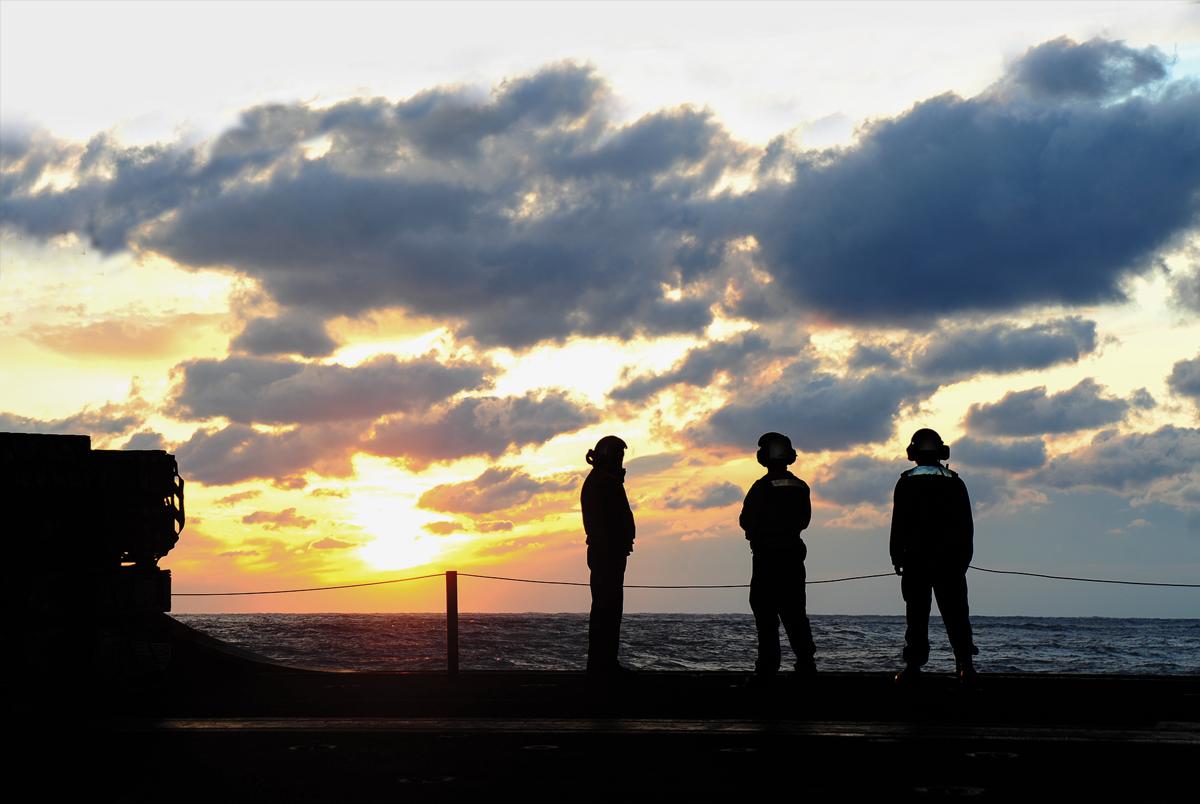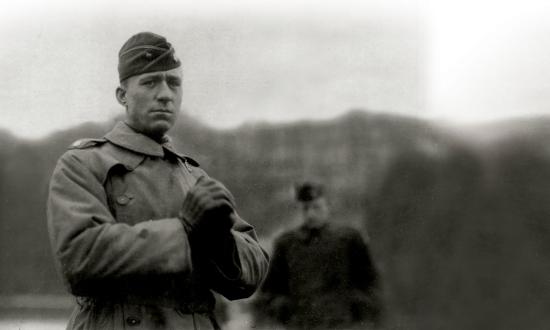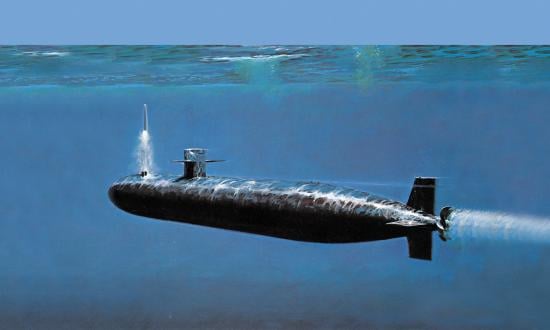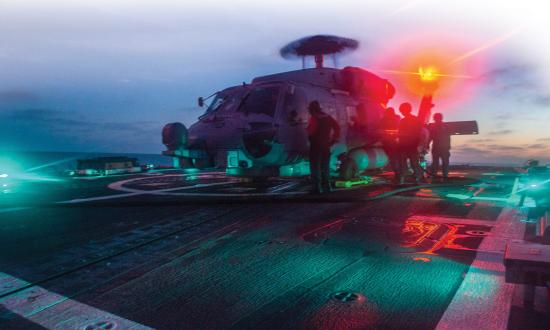Lieutenant Andrew Ray, U.S. Coast Guard
“Set Law Enforcement Phase 2” was piped at 0300, one month into my first counternarcotics patrol. The USCGC Gallatin (WHEC-721) lookout spotted a drug-smuggling go-fast vessel. While under way on Gallatin’s small boat traveling 40 knots in pursuit, I heard “BANG! BANG!” shatter the night’s silence, as the airborne sniper shot out the smuggler’s engines.
Captain Terry S. Wichert, U.S. Navy (Retired)
My first underway as a new submarine commanding officer—wearing the same dolphins my wife helped pin on me when I qualified in submarines 15 years earlier!
Vice Admiral Kevin Green, U.S. Navy (Retired)
During the summer of 1970, I served on board a German torpedo boat in the North Sea. During an exercise Commodore Klose told me, “My last time at sea with an American was Normandy. We ran to the Baltic—fast. Midshipman, the sea is yours.” That’s how Black Shoes are made.
Captain Fabio L. Salas, U.S. Marine Corps
I am a former drill instructor who transitioned to serve as an officer. After more than 20 years of service, witnessing the transformation my young Marines go through over the course of their careers continues to give me more job satisfaction than anything else I do in the Marine Corps.
Captain David Scott, Medical Corps, U.S. Navy Reserve (Retired)
When one of my corpsmen showed remarkable courage under fire, it was my privilege to recommend her for recognition and to pin on her award. Being able to do that for one of my people made me feel I was exactly where I ought to be.
Laurence Wilson, U.S. Navy Veteran
I was an E-5 and the senior fire control technician in gun plot on board the USS Cochrane (DDG-21). It was November 1983, and we were engaged in naval gunfire support off the Philippines. We expended 1,600 five-inch rounds in just over 18 hours. I was the plotting room officer and thought “Who else in the world gets to do this for a living!”
Lieutenant M. Scott Lassiter, U.S. Navy
It was the first time a sailor came to me, on the verge of tears, trying to figure out how to deal with all the stress and conflicts. It takes a lot of trust to open up like that. That moment made my career worth it.
Rear Admiral Fred L. Ames, U.S. Coast Guard (Retired)
As a new ensign and one of two rescue swimmers, I was helping to evacuate more than 30 crew members from a disabled merchant vessel in the Atlantic. As one evacuee began his climb up our scramble net, he fell back into the sea. The other swimmer and I immediately jumped in, grabbing onto him before he could go under and assisted with his hoist. The evacuee looked at me and said, “I thought I was a goner.” I thought to myself, “Now this is why I joined the Coast Guard.”
Craig Faust, U.S. Navy Veteran
I was a young sailor on a very old ship in 1979. The ship had finished a long winter in a Brooklyn shipyard and was finally underway. I looked at the tall buildings of Manhattan and thought of all those people trapped behind those windows while I was going to sea again. I felt like I was escaping a trap and counted myself as very lucky. I had a few epiphanies in the Navy, but that one really drove the point home.
Captain Rich Sloane, U.S. Navy (Retired); Golden Life Member
Fresh out of college and somewhat rudderless I signed up for Navy Officer Candidate School. Six months later I was standing on the engine cover of an LCVP (Higgins boat) taking a wave of boats to the beach, thinking that my contemporaries were selling dresses at Macy’s. “Hi Diddle-Dee-Dee, a Sailor’s life for me!”
Commander N. J. Hall, Royal Navy (Retired)
In 1982, I went to war and I wondered how I would react in combat. The training immediately kicked in and, coupled with the exemplary calm, professional behavior under fire by my command team and ship’s company, I felt confident. I knew then I had made the right career choice.
Captain Don Walsh, U.S. Navy (Retired), PhD
In the late 1970s, I had a meeting with Admiral John Hayes, the 16th Commandant of the Coast Guard. During our discussion about U.S. ocean policy issues (I was on a Presidential Commission at the time), I told him how much I admired the Coast Guard during my Navy career. His response was memorable, “Don, you have to realize that, in the Coast Guard, we fight our wars every day.” In my opinion, this is about as good a “why” as any Coast Guardsman could say.
Lieutenant Commander Steve Bannat, U.S. Navy (Retired), Life Member
I was a fresh caught ensign on a test ship for the shipboard Sea Sparrow. We test fired more then 30 missiles in two months, with daily returns to port to reload. Loads of shiphandling experience. Got home and remarked to spouse, “They actually pay me to do this.”
Eugene A. Silva, Navy Veteran, Life Member
I served in a recommissioned World War II fleet oiler. She wasn’t pretty, and steam winches were her primary strength. During the Cuban Quarantine, we fueled combatant ships for 30 days, with consolidations keeping us at sea. We were part of a Navy team doing what our Navy has done since 1775.
Bob Thompson, U.S. Marine Corps Reserve
It came well after I left the Navy and retired from my civilian job. I asked myself, “What was the most consequential decision I ever made?” The answer, after seven decades: “I joined the Navy.” What an experience! What people!
CWO5 John Harris, U.S. Army (Retired), Life Member
On 11 August 1967, while submerged on board the USS Bluegill (AGSS-242) as a 15-year-old Naval Sea Cadet, I was summoned to the conning tower by the commanding officer. It being my first time submerged, he allowed me a brief look through the periscope. This unique opportunity sealed my desire to pursue a military career. Although I switched to the Army at the age of 17 and served as a soldier for the next 44 years, my naval roots have always been appreciated.
Commander William H. Grimball III, U.S. Navy Reserve (Retired)
I was invited by the naval station senior enlisted personnel to accompany them on a 36-foot motor launch to deliver three pilots. They knew it was going to be rough and I suspected they figured to watch me get seasick. However, they got seasick and I took control of the boat. We got into a trough and 45 degrees all around there was mean, green water. I was very frightened, but I got the job done.
Chief Petty Officer Tom Carver, U.S. Navy (Retired)
My platoon in Vietnam in 1968 called a meeting when the corpsman arrived. A corporal said, “We want to know if we can trust you.” The corpsman replied, “You do your best to keep me alive and I’ll do my best to keep you alive.” From the back someone yelled, “He’s good.” Loyalty and brotherhood—that’s why I joined.
Jack Warth, U.S. Navy Veteran
My best friend and I spent a lot of time around the lake front, where the local Naval Reserve unit had a World War II–era patrol craft, the USS PC-1233. We joined the reserve and spent much time on her. Later, we both became real sailors, attending A school in San Diego, and then, prior to Korea, sailing around South America and back on board the USS Oriskany (CV-34).
Captain George L. Rettie, U.S. Coast Guard (Retired), Golden Life Member
In 1957–59, I commanded a patrol boat on Harbor Entrance Patrol in San Francisco. One winter night, on an inbound transit the bar pilot alerted us to a light in the water on the bar. We began a search off San Francisco’s Ocean Beach and soon found two brothers in personal flotation devices. They were cold, wet, and weary, with a flashlight they thought to bring as their boat swamped north of the channel in the famous “potato patch,” a shoal that forms a formidable shipping hazard outside the Golden Gate Bridge. We transported them to waiting ambulances at Pier 45. Returning to station, I expect everyone on the boat was thinking “This is why I joined.”
Captain David L. Teska, U.S. Coast Guard Reserve (Retired)
In April 1992, I was a lieutenant (junior grade) when I stepped off a plane in Manama, Bahrain to begin a temporary tour in support of maritime interception operations after the 1991 Persian Gulf War/Operation Desert Storm. To be a part of something historic and larger than myself was why I joined the Coast Guard.
Commander Paul Dix, U.S. Navy (Retired)
In the mid 1950s, while an engineman third class on the submarine USS Grouper (SSK-214), I made the fateful decision to reenlist. I was subsequently selected for nuclear power, served on board the USS Seawolf (SSN-575), made chief, and later selected for the limited duty officer program. I qualified for my gold dolphins on board USS Irex (SS-482), served on two submarine squadron staffs, did three executive officer tours, and completed two command tours before retiring.
Kent Bahr, U.S. Army Veteran
One day in high school, sitting at study hall in the library, I pulled the book Submarine by Edward L. Beach from the shelf. I fell in love with submarines! After high school, I went to the Navy recruiter and enlisted with the intent to go to submarine school. I failed the physical due to my eyesight. In 1968, I joined the Army and went to Vietnam. However, my love for submarines, their history, and the people who serve in them has never gone away. My library is full of submarine books and continues to grow. Failing the Navy eye exam caused me to wonder if I was somehow not good enough to serve my country. Entering the Army proved that yes, I was good enough.
Bill Lindblad, U.S. Navy Veteran
At sunrise on watch in the middle of the Pacific Ocean on board a destroyer in the 1950s. I was a junior officer then and being a seafarer was a time of fulfillment for me.







